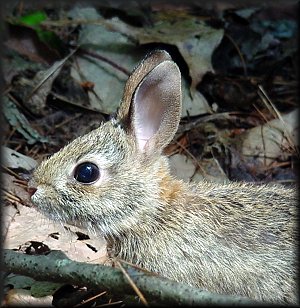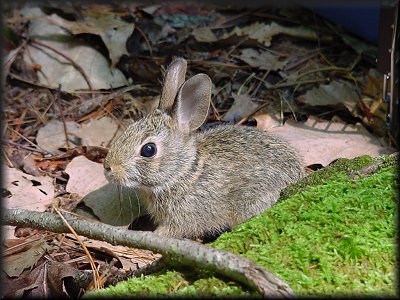
One of the best known wild animals is the cottontail rabbit (Sylvilagus floridanus). Sylvilagus means "woods hare". They are found everywhere east of the Rocky Mountains, other kinds of cottontails occur in the West. Most American rabbits never dig tunnels or burrows, but they will borrow a burrow abandoned by another animal. They will use these burrows to escape bad weather or a foe in hot pursuit. They normally make their homes in brambly thickets or briar patches that offer protection against their many enemies. These shelters - called forms - are little more than scratched out depressions in tall grass or weeds. Around here they make their homes in Blackberry thickets, which I think is pretty smart - food and shelter all in one! Plus the thorns on the bushes will keep most things out. Like me!
They are fond of all green growing things and generally feed early in the morning and later in the day to evening. In winter they feed on bark of trees, shrubs, buds, and berries. I have also seen them graze below the bird feeder, looking for sunflower seeds. Rabbits also like my strawberries, but I keep the berries netted and hope for the best. Personally I would rather find a rabbit in the berry patch than a snake, which likes berries too.

They have been known to jump more than 8 feet. The cottontail rabbit is generally timid, but is fierce in defense of its young and nest. Rabbits can raise up to 6 litters a year, averaging 5 to 7 young, though less than 25% survive their first year. Thus if all broods lived and reproduced, one rabbit at the end of 5 years would have established an empire of 2.5 billion bunnies.
Cottontails are from 14 to 16 inches in length and weigh from 2 to 3 pounds. They are brown with buff sides and with white under bellies. Also they have the fluffy white underside of tails that give them their name. American rabbits generally live alone.
These small cottontail rabbits were released after being rehabbed by Christy of WNC-Rehab. They were found and brought to the local Nature Center, who calls licensed rehabilitators to take care of them until they are old enough and well enough to be released on their own. As small and as cute as they look, the rabbits were very wild. They did not want anyone to reach into their cage to put food in and the rabbits would be very aggressive to them.